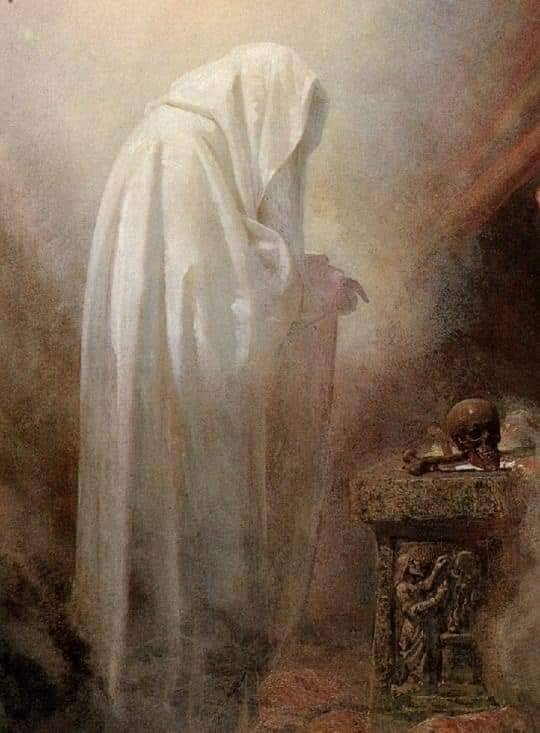#Edward Henry Corbould
Text
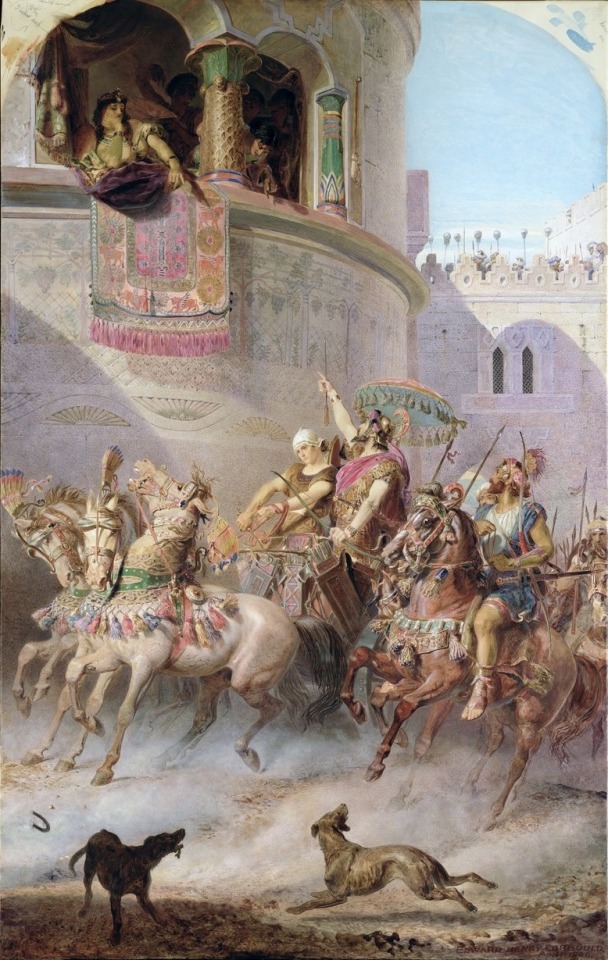
Jehu Enters the City of Jezreel by Edward Henry Corbould
#edward henry corbould#art#jehu#king#israel#jezreel#palace#window#jezebel#queen#architecture#chariot#chariots#horse#horses#biblical#bible#levant#eastern mediterranean#Israelite#israelites#city#dogs
64 notes
·
View notes
Photo

Edward Henry Corbould (1815-1905), 'Lord Ullin's Daughter', ''The Book of British Ballads'' by Samuel Carter Hall, 1842
Source
#edward henry corbould#british artists#lord ullin's daughter#the book of british ballads#samuel carter hall#thomas campbell#wood engravings#engravings#vintage art
405 notes
·
View notes
Text

Edward Henry Corbould - (1815-1905) - "Astarte"
He was a British painter and draughtsman on wood, etcher and sculptor; pupil of his father Henry Corbould; appointed drawing master to Queen Victoria's children, 1851-72; married to Fanny Jemima, daughter of the engraver Charles Heath.
Astarte is the Canaanite/Phoenician goddess of love, sex, war and hunting who developed from the Mesopotamian deity Inanna/Ishtar. She is often depicted with horses and chariots after her arrival in Egypt and as a beautiful naked woman, sometimes with wings or horns, as she was in the Canaanite/Phoenician regions, which also associated her with the dove, the bee and the lion.
#Edward Henry Corbould#artistsupport#Astarte#Ishtar#Inanna#british artist#british painter#mytology#ancient egypt#phoenician#biography#paintings
49 notes
·
View notes
Text
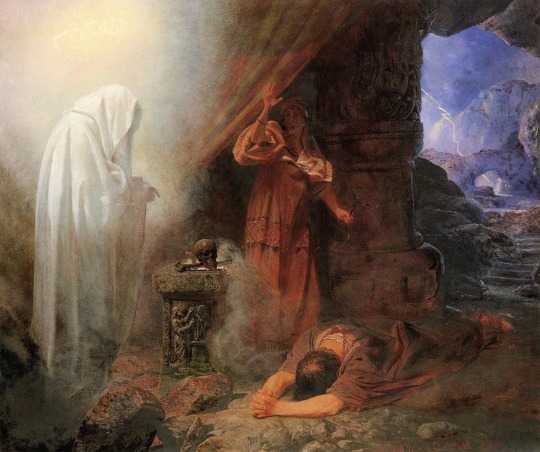
Edward Henry Corbould - Saul and the Witch of Endor, 1860.
8 notes
·
View notes
Photo

Edward Henry Corbould (British painter) 1815 - 1905
Elaine, the Lily Maid of Astolat, 1867
oil
43 notes
·
View notes
Text

The Warhorse by Edward Henry Corbould (1815-1905)
61 notes
·
View notes
Text

scene from Romeo and Juliet in The Complete Works of Shakespeare (1850)
painting by E. Courbould
engraved by John Rogers
2 notes
·
View notes
Text
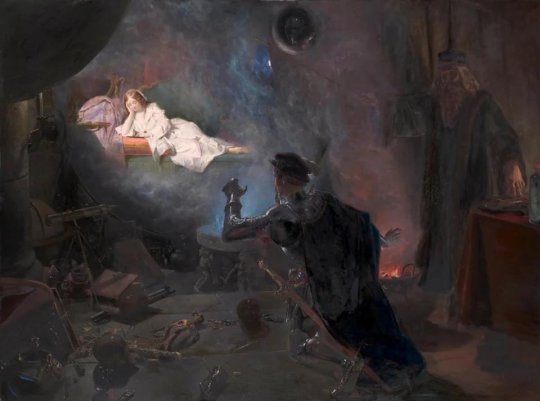
This is a painting by Edward Henry Corbould from 1853 depicting Agrippa conjuring the image of Henry Howard, Earl of Surrey's love.
4 notes
·
View notes
Text
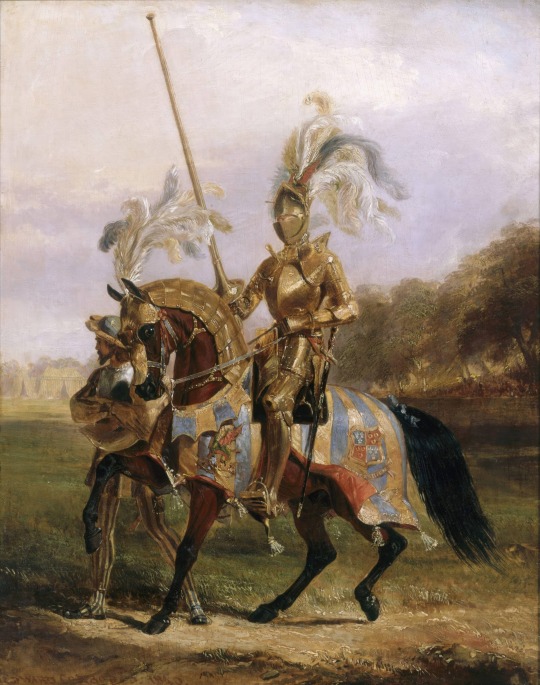
Lord Eglinton and Winton, Dressed as Lord of the Tournament (Edward Henry Corbould, 1840)
2 notes
·
View notes
Text
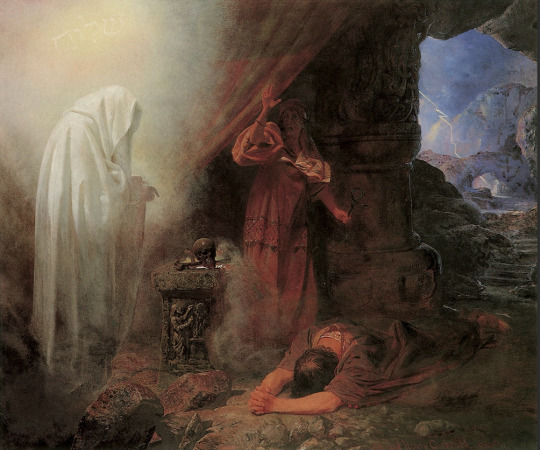
"The Witch of Endor" 1853
⎼Edward Henry Corbould (1815-1905)
Oil on canvas 66 x 78.7 cm or 25 3/4 x 30 3/4 in

Technique:
"The Witch of Endor" by Edward Henry Corbould is a captivating painting that depicts a scene from the biblical narrative of King Saul consulting the medium or witch of Endor to conjure the spirit of the deceased prophet Samuel. The artwork offers a rich interplay of artistic elements, symbolism, and narrative context.
Paint Application and Color Palette:
Corbould's painting exhibits a meticulous paint application, characterized by smooth and detailed brushwork. The color palette predominantly consists of earthy and muted tones, reinforcing the solemn and mysterious nature of the scene. The dark background contrasts with the illuminated figure of the witch, drawing attention to the central focus of the composition.
Technique Type:
The painting showcases a blend of academic and narrative painting techniques. Corbould skillfully combines realistic rendering with narrative storytelling, emphasizing both the visual aesthetics and the emotional impact of the scene. This technique allows the viewer to engage with the story while appreciating the technical prowess of the artist.
Atmosphere:
The atmosphere of the painting is charged with a sense of tension and mysticism. The dark background and the intense gaze of the witch create an eerie and otherworldly ambiance, setting the stage for the supernatural encounter between the living and the deceased.
Perspective:
Corbould employs a dynamic composition with a central focal point. The witch and King Saul are positioned prominently in the foreground, while the ghostly figure of Samuel emerges from the mystical mist in the background. This compositional choice enhances the narrative impact and guides the viewer's gaze through the scene.
Color Theory:
The color palette is dominated by subdued and earthy tones, contributing to the somber mood of the painting. The contrast between the warm tones of the witch's attire and the cooler background hues adds visual interest and reinforces the separation between the living and the spiritual realms.
Proportions:
The proportions of the figures are well-balanced and anatomically accurate, reflecting the artist's proficiency in figure drawing. The careful attention to proportion lends a sense of realism to the supernatural encounter, making it more relatable to the viewer.
Texture:
Corbould's painting exhibits a smooth and refined texture, achieved through the artist's skillful brushwork. The fine details in the fabric of the witch's clothing and the textures of her surroundings contribute to the overall realism of the scene.
Transitions:
The transitions between light and shadow are skillfully executed, enhancing the three-dimensional quality of the figures. The play of light on the witch's face and garments creates a sense of depth and volume, contributing to the overall visual impact of the painting.
Focal Points:
The focal points of the painting are the central figures of the witch and King Saul. Their expressions and body language convey a range of emotions, from the witch's intense concentration to King Saul's mixture of desperation and apprehension. These focal points draw the viewer into the narrative and emotional core of the artwork.
Symbolism:
The painting's symbolism is deeply rooted in biblical narrative and spirituality. The witch serves as a conduit between the living and the spiritual realm, embodying the intersection of the mundane and the supernatural. The ghostly figure of Samuel represents the unknown and the spiritual world, evoking a sense of mystery and awe.
Layering:
Corbould employs layering techniques to create depth and dimension within the composition. The layers of mist and haze in the background contribute to the ethereal quality of the spiritual realm. This layering technique reinforces the separation between the physical and supernatural elements of the scene.

Above is the image I used for my analysis. Here, I have highlighted my eye's journey across the work in green. I used to pink lines to denote reinforcing lines and form and blue lines to show reinforcing areas of contrast.
Artist History:
Edward Henry Corbould, a prominent 19th-century British artist, left an indelible mark on the Victorian art scene with his captivating narrative paintings and meticulous attention to detail. Born on November 5, 1815, in London, Corbould's artistic journey was characterized by his ability to intertwine historical and literary narratives with artistic technique, contributing to the rich tapestry of Victorian visual culture.
Early Years and Artistic Beginnings:
Growing up in a family of artists, Edward Henry Corbould was surrounded by creativity from a young age. His father, Henry Corbould, was an accomplished engraver, while his siblings also pursued artistic endeavors. The family's artistic environment nurtured Edward's early inclinations towards drawing and painting. He studied at the Royal Academy Schools, a prestigious institution that played a crucial role in shaping his artistic skills and sensibilities.
Narrative Excellence and Victorian Culture:
Corbould's artistic talents blossomed within the Victorian context, a period characterized by a fascination with history, literature, and storytelling. His ability to create intricate narrative compositions made him a sought-after artist for illustrating books, magazines, and historical scenes. His works often featured scenes from mythology, literature, and history, capturing the imagination of Victorian audiences who were eager to engage with visual stories that reflected their cultural values.
Illustrating Literary Classics:
One of Corbould's significant contributions to Victorian art was his skillful illustration of literary classics. He collaborated with renowned authors such as Charles Dickens, providing illustrations for editions of "Oliver Twist," "The Old Curiosity Shop," and "Martin Chuzzlewit." His ability to visually capture the essence of characters and scenes complemented the narrative power of these literary works, creating a harmonious synergy between text and image.
Embodying Victorian Morality and Values:
Corbould's artistry often aligned with the moral and cultural values of the Victorian era. His works resonated with the Victorian emphasis on family, virtue, and social order. His ability to depict scenes that evoked empathy and sentimentality reflected the prevailing sentimentality of the time, as well as his own empathetic engagement with the subjects he portrayed.
Narratives and Technique:
Corbould's narrative paintings were characterized by meticulous attention to detail, a trait that elevated his compositions to a level of historical and artistic significance. His mastery of technique allowed him to create compositions that were not only aesthetically pleasing but also emotionally resonant. His figures were rendered with anatomical accuracy and a profound understanding of human expression, allowing viewers to connect with the characters and stories he portrayed.
Legacy and Lasting Influence:
Edward Henry Corbould's artistic legacy endures through his contributions to Victorian art and culture. His illustrations and paintings continue to be admired for their narrative depth, technical excellence, and historical significance. His work exemplifies the marriage of art and literature that defined the Victorian era, reminding us of the power of visual storytelling to transcend time and resonate across generations.
Later Years and Passing:
As the Victorian era transitioned into the 20th century, Corbould's artistic style encountered evolving artistic movements and sensibilities. Despite the changing artistic landscape, his contributions remained a testament to the narrative and technical achievements of his time. Edward Henry Corbould passed away on November 20, 1905, leaving behind a legacy that continues to inspire artists, historians, and enthusiasts interested in the intricate interplay of art and narrative.
In conclusion, Edward Henry Corbould's artistic journey exemplifies the marriage of artistic technique and narrative storytelling that defined Victorian artistry. His ability to capture the essence of historical and literary narratives through his meticulous paintings and illustrations left an enduring mark on the cultural landscape of his era. Corbould's work continues to illuminate the richness of Victorian visual culture, inviting us to explore the stories and sentiments that captivated the hearts and minds of a bygone era.
Time Period/Anthropology:
During the years spanning from 1850 to 1860, Britain underwent a period of profound societal, economic, religious, and cultural transformation. These decades were marked by significant shifts in various aspects of life, with events and developments shaping the daily lives of the population.
Sociopolitical Climate:
The sociopolitical landscape of Britain in the mid-19th century was characterized by a complex interplay of social classes and political ideologies. The Victorian era, named after Queen Victoria's reign (1837-1901), was known for its emphasis on morality, social order, and domestic values. The Whigs and Tories were the major political parties, and debates over suffrage, workers' rights, and education reforms were prominent. The Great Reform Act of 1832 had expanded voting rights to a portion of the middle class, but efforts for further reforms continued. The Chartist Movement sought political rights for working-class men and led to the presentation of the People's Charter in 1838.
Economic Climate:
The mid-19th century witnessed the height of the Industrial Revolution in Britain, with rapid urbanization and industrialization altering the economic landscape. Factories, mines, and railways proliferated, transforming agricultural societies into industrial ones. This period saw the expansion of the British Empire, which facilitated trade and access to resources. Economic disparities widened, and labor conditions were often harsh, leading to movements advocating for workers' rights. The repeal of the Corn Laws in 1846, which had imposed tariffs on imported grain, reflected a shift towards free trade and liberal economic policies.
Religious Climate:
Religious diversity and change were significant aspects of the era. The Church of England remained the established church, but there was a growing variety of religious expressions. The Oxford Movement, a high-church movement within Anglicanism, sought to revive traditional practices and rituals. Nonconformist groups, including Methodists and Baptists, gained prominence, emphasizing personal piety and social reform. Additionally, the period witnessed the rise of secularism and skepticism as scientific advancements and intellectual shifts challenged traditional religious beliefs.
Cultural Climate:
The cultural milieu of the mid-19th century was marked by a fascination with history, art, literature, and scientific discoveries. The Victorian era saw a flourishing of literature, with authors such as Charles Dickens, Charlotte Brontë, and George Eliot exploring societal issues in their works. Artistic movements like the Pre-Raphaelite Brotherhood sought to reconnect with medieval aesthetics and nature. Photography emerged as a new medium, capturing both the splendor and struggles of the time. Museums and exhibitions provided platforms for cultural exchange and education.
Impactful Events on Daily Lives:
Several events during this period had a direct impact on the daily lives of Britons. The Crimean War (1853-1856) brought attention to poor medical and sanitary conditions in military hospitals, prompting Florence Nightingale's pioneering efforts in nursing and healthcare reform. The 1851 Great Exhibition showcased technological innovations and products from around the world, offering glimpses of progress and advancements. The Public Health Act of 1848 and the Artisan Dwelling Act of 1875 aimed to address urban overcrowding, sanitation, and housing issues. The launch of the first public railways improved transportation and facilitated movement within and between cities.
Personal Note:
I initially came across a cropped version of this painting of just the cloaked figure. Once I found the full painting, I knew that I'd have to cover it. The sheer amount of detail is breathtaking. There is an aura about it that I found captivating.
4 notes
·
View notes
Text

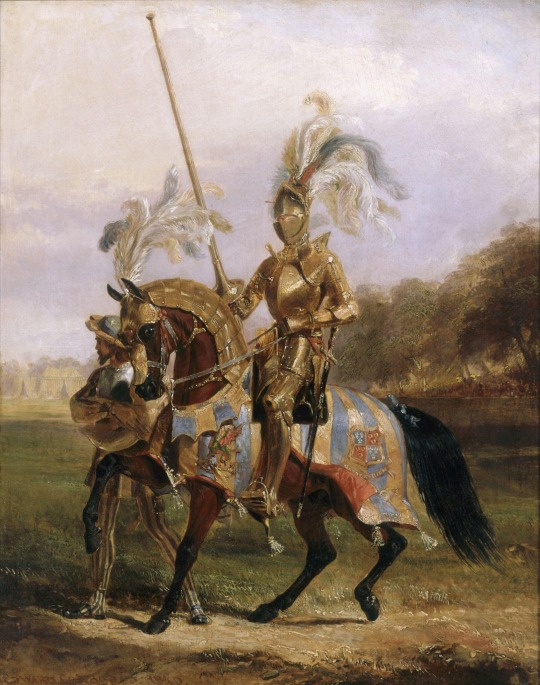
Lord Eglinton dressed as the Lord of the Tournament
by Edward Henry Corbould
#edward henry corbould#lord eglinton#lord#tournament#knight#gold#armour#lance#joust#art#painting#history#britain#romantic#romanticism#chivalry#knights#chivalric#medieval#costumes#middle ages#victorian#victorians#british#eglinton tournament#processions#competitions#earl of eglinton and winton#plumes#eglinton castle
335 notes
·
View notes
Text
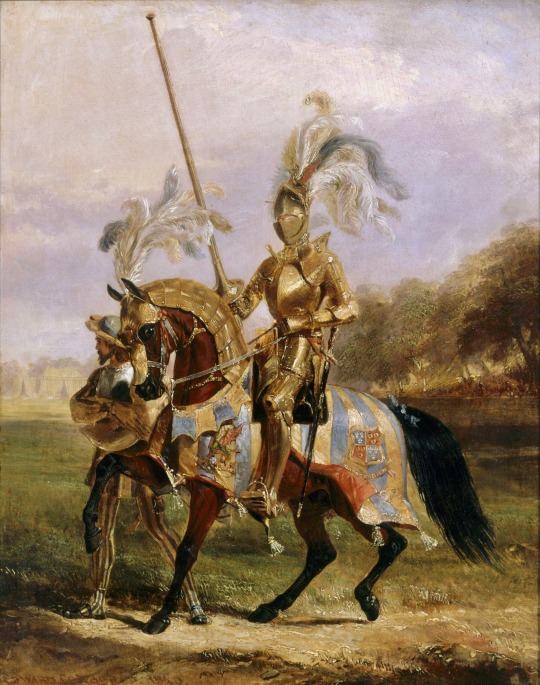
Oil painted entitled 'A knight entering the lists at Eglinton Tournament' by Edward Henry Corbould. Great Britain, ca. 1840.
VAM
30 notes
·
View notes
Text
28 Works, December 5th. is Edward Henry Corbould's day, his art, illustrated with footnotes #245
28 Works, December 5th. is Edward Henry Corbould’s day, his art, illustrated with footnotes #245
Edward Henry Corbould (British, 1815–1905)The Earl of Surrey beholding the Fayre Geraldine in the magic mirror,, c. 1853Pencil and Watercolor92.7 x 125.7 cm. (36.5 x 49.5 in.)Private collection
The curious painting was inspired by an apocryphal episode in the life of the gallant and unfortunate Henry Howard, Earl of Surrey — courtier, soldier and poet at the court of Henry VIII, who was…

View On WordPress
#Art#Artists#Biography#Edward Henry Corbould#Eglintonc#fineart#footnotes#Héloïse#History#Odalisque#Paintings#Zaidan
2 notes
·
View notes
Photo
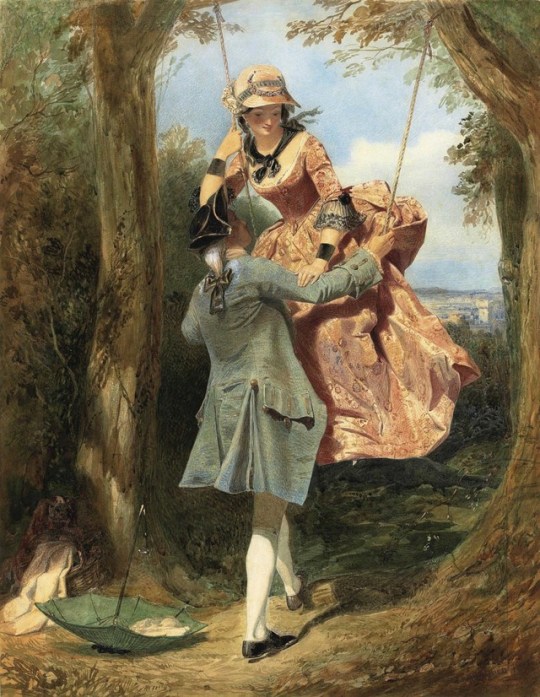
Premier livre de pièces de clavecin, Ordre 2 : Gavotte – François Couperin
La balançoire (The Swing)
Edward Henry Corbould, 1848
#art#painting#classical music#19th century#British art#Edward Henry Corbould#1800s#1800s art#François Couperin#baroque#classical art
1K notes
·
View notes
